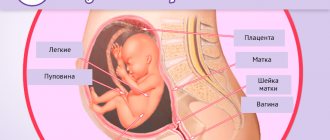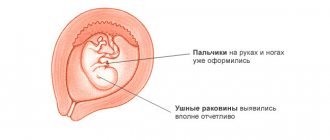Causes of low presentation
Symptoms of low presentation
Dangers of low presentation
Detection of low presentation
Correcting behavior in low presentation
During an “interesting” situation, a woman’s emotional state needs understanding, support, and care. Not every pregnancy goes according to plan. Without knowing what a particular message means, it is difficult to find the right actions to solve emerging problems.
Hearing about the low location of the fetus and placenta, panic arises that can interfere with sound reasoning. What do these words mean?
With a low presentation, the baby is located close to the cervix, putting pressure on it. Both the bladder and intestines experience additional weight. This leads to frequent urges, which are not uncommon during this period, and creates the likelihood of a disease such as hemorrhoids.
How to determine the belly is low during pregnancy
- constitutional features of a woman’s body;
- low location of the placenta;
- weak abdominal muscles;
- repeat pregnancy;
- the beginning of labor.
At the beginning of fertilization, the uterus vigorously grows and changes, without visually showing this on the woman’s body.
In the period up to 16-20 weeks, the pregnant woman’s belly does not yet increase, and determining its location is practically impossible. It is possible to establish a deviation from the norm only through an ultrasound examination.
A low abdomen during pregnancy in the first trimester is primarily due to the direct location of the fertilized egg in the uterine cavity.
For example, if the embryo is attached to the wall of the uterus near the cervix, a low attachment of the placenta and the very location of the child are formed.
In this case, the fetus, as it grows, puts pressure on the placenta and injures it, increasing the risk of detachment and squeezing of the umbilical cord.
In obstetrics, this phenomenon is not considered a high-risk group, but physical activity and active life (including sexual activity) are not recommended for such symptoms.
Due to the close location of the placenta to the cervix, any shocks (especially during sex) can provoke its detachment. There are no preventive measures to minimize the formation of a low fetal position (low abdomen during pregnancy), although doctors recommend conducting a full examination of the body immediately before conception and avoiding abortion.
A low belly during pregnancy in the last trimester is characterized, first of all, by the early birth of the baby.
Such signs begin several weeks before the expected date of birth, and indicate that you will soon become a mother, and you need to prepare to go to the maternity hospital when given a signal.
But, if the baby rapidly declines in the middle of the third trimester, there is a risk of premature birth. You simply cannot do without professional consultation and ultrasound diagnostics.
Moms, don’t forget, no matter what shape, height, or roundness your tummy is, the most important thing is to find the positive in everything, at least for nine months. After all, the mental and emotional state of the mother is transmitted to the baby. But it is important for every woman that her child is healthy! There are many signs and debates devoted to the topic of the pregnant belly. For example, it is customary to determine the sex of the unborn baby based on its shape. However, doctors have their own opinion on this matter.
Neither the size nor the location of the womb affects the development of the fetus, much less its gender.
Abdominal growth is an individual process and what is normal for some may cause discomfort or cause complications for others.
Low abdominal position during pregnancy
Having the abdomen too low is not the most dangerous symptom. In most cases, it speaks of the appropriate location of the fetus in the uterus. To successfully carry such a pregnancy, it is enough to observe a number of precautions and follow the recommendations of doctors.
In girls whose belly is low throughout pregnancy, the likelihood of premature birth or complications during the expulsion of the fetus is slightly higher.
The second trimester causes more excitement for women. Many changes occur in the body. The abdomen becomes rounded, the ligaments and muscles in the abdominal area stretch, and the pelvic bones gradually begin to separate. Moreover, from a physiological point of view, this period is considered the most calm and measured.
The position of the abdomen in the second trimester is determined by the degree of development of muscles and tendons. Basically, only its lower part is noticeable. If a girl did little sports before pregnancy, the ligaments quickly lose their elasticity and the stomach drops lower. The site of fetal attachment may be completely normal.
To minimize and prevent muscle strains, a special bandage is used. The design reduces the load on the stomach, spine and back. The weight of the fetus, which grows every day, is redistributed to the entire musculoskeletal system.
It is better to entrust the selection of a suitable bandage to your obstetrician-gynecologist. There are many types on the market, each designed to solve a specific problem.
An alternative to the usual bandage is special clothing for pregnant women - panties, leggings. It performs the same function and protects against temperature changes, mechanical damage, and improves blood circulation.
The last trimester of pregnancy is the period of preparation directly for childbirth. At this time, you need to pay special attention to your feelings and changes in the body.
Abdominal prolapse is considered one of the signs of the imminent onset of labor. Usually, from the moment the belly drops, a woman has another 1-2 weeks left before the long-awaited event.
It's time to pack your things for the maternity hospital and prepare the other parent for the news.
In multiparous women, the belly may drop a day or several hours before giving birth.
If the due date has not yet come, and the stomach has dropped, there is a high probability of premature labor. You should immediately consult a doctor or go to the hospital yourself. Without a professional examination and ultrasound examination, it is impossible to determine the cause of the problem.
Alarming symptoms
Placental abruption, leakage of amniotic fluid, increased uterine tone are pathologies that often accompany a suddenly drooping abdomen. They are accompanied by accompanying symptoms:
- prolonged cramping pain;
- spotting, bleeding;
- copious mucous discharge;
- copious discharge, like water.
If you discover a similar clinical picture, you must immediately call an ambulance. Treatment and diagnosis are carried out in a hospital setting, under the supervision of doctors.
Preventive measures
Regular physical activity and high-quality nutritious nutrition at the planning stage and in the early stages will help avoid prolapse. Doctors recommend pregnant women to do yoga, swimming, fitness, and stretching. The diet should be dominated by protein products and fiber, which have a beneficial effect on the formation of the muscle corset and musculoskeletal system.
Low position of the fetus during pregnancy
- Last seen:Yesterday 23:02:30
Has anyone had this happen where the baby’s head was lying very low and was there a threat? How did you leave? what was bothering you?
- Children: Furry Dragon and little Scorpio
- :
- Last seen:Yesterday 22:56:28
I retreated until the victory. At 34-35 weeks, the doctor prescribed papaverine suppositories and basically lay down (I had to promise not to go to the hospital). Nothing bothered me much, sometimes I felt pressure in the lower abdomen, but not much. A! And she wore a bandage, of course.
ol4aI went through 2 pregnancies like this. But I was as healthy as an ox. And I felt the same way. With the latter I wore a bandage. They even wanted to give me a ring. But you must listen to yourself and not take risks.
They even wanted to give me a ring
I went through 2 pregnancies like this. But I was as healthy as an ox.
I have the same thing, the first B doctor sounded the alarm at 34 weeks, saying that I was about to give birth ahead of schedule, but that was not the case, she was more than 41 and would have gone further if labor had not been induced, although all B was very mobile and active. The second pregnancy, the same thing, the doctor said that it’s just such physiology and it’s normal that the baby is low right away.
Edited by Nastusikplusik (31-03-2013 14:33:23)
the doctor said that it’s just physiology and it’s normal that the baby is low right away
and the fetus did not put pressure on the neck, did it shorten prematurely? didn't you install anything like that?
- Last seen:Yesterday 22:41:39
My baby was low and his neck was shortened. I don’t remember by centimeters, but already at 19 weeks, at the examination, it was shorter than necessary, the tone. Around 24 they put a ring in the train station on the 3rd floor. At that time (3 years ago) the ring in Brest was only placed there. This is not an entirely simple procedure. If the cervix is disturbed, there is a possibility that premature birth can be provoked.
Therefore, before and after installation, they stay in the hospital for several days to remove the threat. After lying there, taking all the swabs and reading about this very ring, I refused to have it installed.
Moreover, there for the first time they did an ultrasound of my cervix itself and it turned out that it was not so short. At home, of course, I didn’t run cross-country or lift weights; I lay down whenever possible.
She delivered safely until 41 weeks.
• One is suffering from toxicosis and all she wants is for this to end quickly.
• Another walks without feeling her feet under her, and believes that this is the best period of her life.
• And the third abstracts herself from the whole world and lives for the future meeting with her already beloved baby.
In general, many people surround pregnancy with a veil of mystery, many signs are dedicated to it, it causes such natural experiences. A popular sign is that with a low belly, the mother will give birth to a baby, and with a high, protruding belly, on the contrary, a baby will be born.
If we analyze many examples from our lives, we can easily be convinced that the shape of the abdomen and its location in no way determine the gender of the long-awaited child.
Doctors have their own concerns here, since a low belly during pregnancy most likely tells them that the fetus is too low in the uterus.
In this regard, the doctor will rightly insist on the need to be careful and use a special bandage for pregnant women.
The low belly of tomorrow’s mother itself is determined, first of all, by the duration of pregnancy. This factor should also be considered as requiring increased caution, attention and, first of all, on the part of the woman herself.
Low belly during pregnancy: should you worry?
A low belly during pregnancy, according to old beliefs, means that the expectant mother is growing a girl in her belly. If the belly sticks out forward, it will be a boy.
For every woman, pregnancy brings a lot of new things: some suffer from toxicosis, for some this is the best time in their lives, while others can’t wait for their baby to appear; its gender will be determined from the first days of pregnancy .
But, no matter what the old beliefs say, the shape of the abdomen actually has nothing in common with sex determination. But a low belly during pregnancy sometimes raises a number of doubts among doctors.
Often, this may be due to the fact that the fetus is located too low in the uterus, so the doctor should warn the pregnant woman to be careful and need to use a special bandage.
But, despite any other indicators, the determining factor in a situation with a low belly, in any case, remains the duration of pregnancy. That is why each period of bearing a child should be considered separately, since each of them has its own risks and features that are directly related to such a problem as a low belly.
In the first trimester, a low belly can be determined as early as the 5th month of pregnancy using an ultrasound.
A low abdomen in this situation, as a rule, may indicate that the developing fetus and placenta are attached too low in the uterus.
Such factors do not pose a threat to bearing a child, but most doctors still strongly recommend not to abuse active physical activity.
Abdominal volume during pregnancy
Every pregnant woman's belly begins to grow at a certain time. This is understandable, because the fetus grows in it, the volume of amniotic fluid increases, and accordingly the uterus itself grows.
At each week of pregnancy, there are certain norms for the height of the uterine fundus and abdominal circumference, but the doctor will begin measuring your abdomen in the second half of pregnancy.
The results obtained will make it possible to determine the presence or absence of pathologies, and will also clarify the duration of pregnancy.
Normally, the height of the uterine fundus should correspond to the duration of pregnancy. The number of centimeters the doctor measures is the number of weeks of your pregnancy.
At the 20th week of pregnancy, the fundus of the uterus is 2 cm below the level of the navel; it reaches the level of the navel at the 24th week; starting from the 28th week of pregnancy, the fundus of the uterus will already be several cm above the level of the navel.
At week 36, the fundus of the uterus will reach the sternum and will not grow from then on.
A low belly during pregnancy, according to old beliefs, means that the expectant mother is growing a girl in her belly. If the belly sticks out forward, it will be a boy.
For every woman, pregnancy brings a lot of new things: some suffer from toxicosis, for some this is the best time in their lives, while others can’t wait for their baby to appear; its gender will be determined from the first days of pregnancy .
Source: https://rody-beremennost.ru/diagnostika/kak-opredelit-zhivot-nizko-pri-beremennosti











